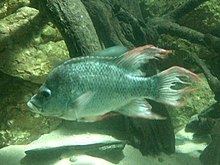Phylum Chordata Order Perciformes | Subfamily Ptychochrominae Scientific name Ptychochromis insolitus Rank Species | |
 | ||
Similar Ptychochromis, Ptychochromis oligacanthus, Paretroplus nourissati, Kotsovato, Paretroplus | ||
Ptychochromis insolitus spawning 2
Ptychochromis insolitus, also known as the Mangarahara cichlid, is a species of cichlid endemic to certain river systems in northern Madagascar. It was first described in 2006 but was then thought to have disappeared, before a remnant population was discovered in 2013. The fish, just 5.5 cm (2.2 in) long, is threatened by habitat loss and introduced species and the International Union for Conservation of Nature has assessed it as being "critically endangered". The fish found in 2013 have been moved into captivity where attempts are being made to breed them.
Contents
Ptychochromis insolitus spawning 1
Status
The Mangarahara cichlid was first described as a new species in 2006 from the Amboaboa and Mangarahara Rivers near Mandritsara in northern Madagascar. It is listed as Critically Endangered by the IUCN, but until its rediscovery in 2013, it was feared that the last remaining wild population had disappeared. This rare species is threatened by habitat loss and introduced species. Prior to its official description, it was sometimes known as Ptychochromis sp. nov. "Joba mena" or Ptychochromis sp. nov. "Mangarahara". Two cichlids from another genus, Paretroplus nourissati and P. gymnopreopercularis, and a round herring, Sauvagella robusta, are restricted to the same region as Ptychochromis insolitus. This species can reach a length of 5.5 centimetres (2.2 in) SL.
In captivity
As of 2013, only three specimens were known to exist in captivity; two males in London Zoo and one male in the Berlin Aquarium. An appeal to collectors was put out in May 2013 to attempt to find a suitable female in a private collection for breeding purposes. The last known female was killed by a male at the Berlin Aquarium while trying to mate. In late 2013, a remnant population was discovered in the wild after a local tip-off, and 18, including some females, have been moved into captivity.
